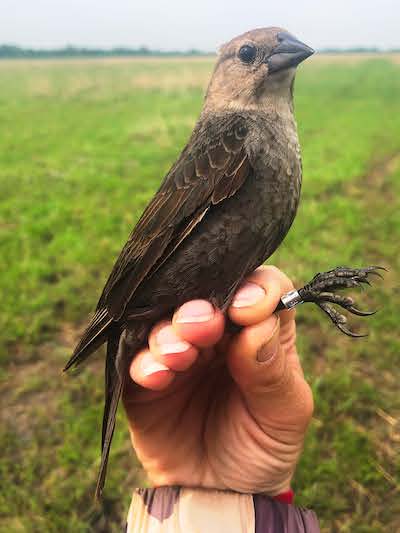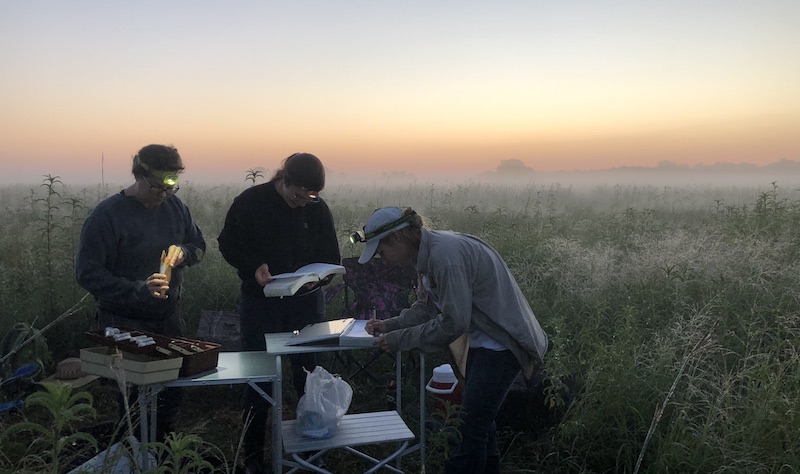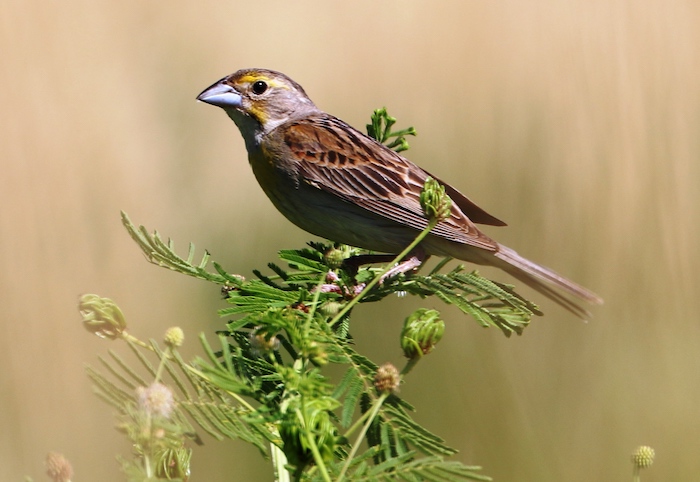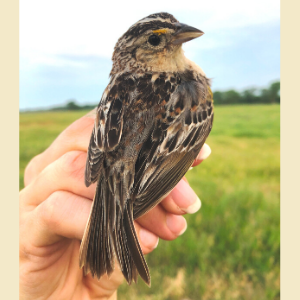Dickcissels are quintessential grassland birds and until the mid-19th century or so they spent their summers on North America's Great Plains with pronghorn antelope, vast herds of bison, and wolves. But European American settlers brought great changes to the plains including intensive agriculture, cattle and fences. Now climate change is bringing even more changes to Dickcissels' "home on the range."
A recent study in the journal Frontiers in Ecology and Evolution used bird banding data from IBP's MAPS program along with weather and land management data climate data to examine the effects of climate and management on Dickcissel (Spiza americana) populations and their vulnerability to brood parasitism by Brown-headed Cowbirds (Molothrus ater). The study found that Dickcissels were less abundant in years with high precipitation in the first part of the breeding season (June), whereas cowbirds were more abundant. This means that lower numbers of Dickcissels nests may be exposed to higher numbers of cowbirds, suggesting that higher June rainfall may contribute to higher levels of brood parasitism of Dickcissels. These findings have troubling implications for declining Dickcissel populations as climate change models predict increased frequency of extreme precipitation events on the Great Plains.
Dickcissels, like many grassland bird species, have seen steep population declines in recent decades. The abundance of North American grassland birds has declined by more than 50% in the last 50 years. Dickcissel populations have declined less dramatically than some other grassland obligate species, but are still considered vulnerable to extinction due to low nest success and adult survival, as well as habitat loss on the grasslands where they breed in North America and the grasslands where they winter in Venezuela.
This study was conducted at a private conservation area in Nebraska's Platte River Valley which is managed by the Crane Trust, a non-profit organization dedicated to the protection and maintenance of critical habitat for whooping cranes, sandhill cranes and other migratory birds in the Big Bend Region of the Platte River Valley. MAPS bird banding stations were operated on the property between 2002-2007 and 2017-2019. Because MAPS data is collected using a standardized protocol, researchers were able to compare data from both periods to assess the abundance and productivity of Dickcissels and cowbirds over a span of 18 years.
Unlike other widespread bird surveys, such as the Breeding Bird Survey, MAPS data allows scientists to measure adult survival and productivity (number of young produced,) as well as abundance of bird species. One of the authors of the study, Dr. Nico Arcilla of the International Bird Conservation Partnership and the University of Nebraska, says the study could not have been done without data from the MAPS program:
The MAPS data made this study possible; we could not have done this study otherwise. Whereas bird surveys can be done in a variety of ways, MAPS data is always collected systematically, according to strict protocols, which means that we could replicate what had been done in the past with confidence that the new MAPS data we collected could be compared with the previous MAPS data. In my opinion, MAPS data is vastly underused and represents a highly valuable resource for understanding how our breeding bird populations are changing over time. This is particularly true because MAPS allows us to measure productivity and other demographic parameters in addition to abundance, so we can get a better picture of what is driving population change.
Rain–within reason–generally benefits Dickcissels and other birds because it leads to an abundance of insect prey and seeds as well as dense growth of the grass, forbs, sedges and shrubs where they hide their nests. But too much precipitation is bad news for these birds. Hail can pummel and knock down nests, and in riparian corridors, like this study area, heavy rain can lead to flooding which destroys nests. When this happens, Dickcissels head for higher ground.

A female Brown-headed Cowbird after banding. Photo by Nico Arcilla.
In contrast, the abundance of Brown-headed Cowbirds increased in years with higher precipitation. Wetter years result in more insects and seeds for cowbirds to eat and since they are brood parasites they are not tied to specific breeding territories or nests. So damage due to flooding or hail has less of an effect on them. And because cowbirds parasitize many species of birds, they have a range of nests to choose from if some Dickcissel nests are damaged.
The researchers found that Dickcissels that do stick it out after extreme precipitation have a higher productivity, or fledge more young, than Dickcissels during lower precipitation years. Arcilla and her co-authors suggest that this may be due in part to "density dependence;" with fewer Dickcissels competing for resources in the area there is more food for nestlings and fledglings. But there is a downside for Dickcissels that stay put: higher potential of parasitism by higher numbers of cowbirds.
Brown-headed Cowbirds parasitize over 200 species of birds, but Dickcissels are one of their favorites. Studies at other sites have shown that up to 48-90% of Dickcissel nests may be parasitized and that parasitism significantly reduces the number of young Dickcissels that fledge from these nests. This study showed that precipitation can affect the ratio of cowbirds to Dickcissels, and that climate change may thus increase the impact that cowbirds have on Dickcissel productivity.
But Arcilla cautions against seeing cowbirds as villains and points out they co-evolved and co-existed with their hosts for millions of years. Their brood parasitism strategy allowed them to live a nomadic lifestyle, following migrating herds of bison across the Great Plains. It is likely only in the last 150 years or so that cowbird parasitism began having significant negative impacts on their hosts' populations. Arcilla explains:
By the late 19th century, the great bison herds had been pushed to the brink of extinction, and new settlers had begun to claim and fence land for farming and livestock. The end of the great herds of migrating bison and introduction of cattle fenced into pastures meant that cowbirds, too, became sedentary during the breeding season, and that their effects on their hosts could concentrate to the point where they become unsustainable. By contrast, historically cowbirds were likely "here today, gone tomorrow," and so would likely not have lingered in any given bird breeding area for any length of time. In this way, the dramatic changes in the human landscape have affected the relationship of this brood parasite with its hosts.
This study highlights how climate change, leading to increased and more extreme precipitation on the Great Plains, may lead to further declines in Dickcissel abundance as well as further declines in productivity due to increasing rates of brood parasitism. Climate change is causing weather patterns to shift in many areas and the authors argue that understanding how these changes affect the relationship between cowbirds, Dickcissels, and other host species will be an important part of informing adaptive management for bird conservation.

MAPS banders at work at dawn on the Crane Trust conservation area in Nebraska. Photo by Madison Sutton.






